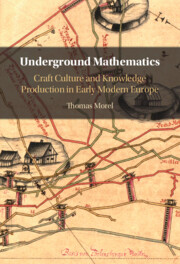Book contents
- Underground Mathematics
- Underground Mathematics
- Copyright page
- Dedication
- Contents
- Figures
- Acknowledgements
- Introduction
- 1 Of Scholars and Miners
- 2 A Mathematical Culture
- 3 The Mines and the Court
- 4 Writing It Down
- 5 ‘So Fair a Subterraneous City’
- 6 How to Teach It?
- 7 ‘One of Geometry’s Nicest Applications’
- Conclusion
- Bibliography
- Index
5 - ‘So Fair a Subterraneous City’
Mapping the Underground
Published online by Cambridge University Press: 08 December 2022
- Underground Mathematics
- Underground Mathematics
- Copyright page
- Dedication
- Contents
- Figures
- Acknowledgements
- Introduction
- 1 Of Scholars and Miners
- 2 A Mathematical Culture
- 3 The Mines and the Court
- 4 Writing It Down
- 5 ‘So Fair a Subterraneous City’
- 6 How to Teach It?
- 7 ‘One of Geometry’s Nicest Applications’
- Conclusion
- Bibliography
- Index
Summary
Chapter 5, ‘“So Fair a Subterraneous City”: Mapping the Underground’, focuses on map-making and the visualization of the underground. It argues that these developments were deeply linked to broad changes in the political structure of mining regions. Drawing mining maps and working on them became widespread in the second half of the seventeenth century, gradually replacing alternative tools such as written reports of visitations, wood models, or annotated sketches. In Saxony, Captain-general Abraham von Schönberg (1640–1711) put his weight and reputation behind the new cartographic technology, hoping that its acceptance would in turn help him advance his reform agenda. At-scale representations were instrumental in justifying new investments, while offering technical road maps to implement them. Johann Berger (1649–1695) spent years producing a monumental cartographic enterprise, the Freiberga subterranea (1693) to support his patron’s ambitions. As surveyors finally realized the old dream of ‘seeing through stones’, the administrations rapidly seized their skills to reform and police their subterraneous cities.
Keywords
- Type
- Chapter
- Information
- Underground MathematicsCraft Culture and Knowledge Production in Early Modern Europe, pp. 149 - 182Publisher: Cambridge University PressPrint publication year: 2022

